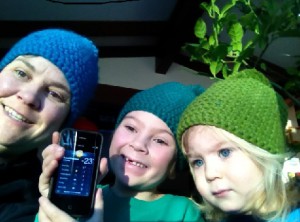Energetic, youthful, admired by her students, Professor Johanna Kramer is our guest for the month of March.

Professor Kramer, please, tell us about yourself.
I am an assistant professor in the English Department. My area of specialization is Anglo-Saxon literature and culture. In my research I am most interested in Old English religious literature, especially homilies and saints’ lives, the transmission of patristic theology into vernacular poetry and prose, and popular religious texts and practices.
My first book, Between Earth and Heaven: Liminality and the Ascension of Christ in Anglo-Saxon Literature, a study of the ways in which the theology of the Ascension is taught and visualized in a wide range of Anglo-Saxon texts, will be published at the end of March by Manchester University Press.
At MU, I teach classes that concern the early Middle Ages, Anglo-Saxon England, and the history of English, for example, Women in the Early Middle Ages, World of the Vikings, Introduction to Old English, and History of the English Language as well as graduate seminars on various topics in Anglo-Saxon and other medieval literature.
How did you incorporate Special Collections into your teaching?
I take almost all of my undergraduate classes for visits to Special Collections. I take my students so that they can have at least minimal exposure to actual medieval materials. I want them to see what different types of medieval manuscripts look like (liturgical, biblical, philosophical, etc.), get a basic sense of manuscript production (both codicology and paleography), and recognize different writing surfaces (papyrus, parchment, even clay). Since I teach in an area—medieval literature—in which primary sources in their original form are not very accessible to students, showing them some of the wonderful materials we have at SC is a small way in which I can have students share the same space and even get in physical contact with manuscripts that were produced a thousand or more years ago. This way, students also become more alert to the fact that the original formats in which we find texts are radically different from the neatly edited and translated versions that students read in class. Aside from seeing what various medieval codices and scripts look like, students get the opportunity to see some of the beautiful illuminations and other depictions that accompany texts, be it a whimsical decoration of an initial, a miniature showing a biblical scene (like the Ascension at the opening of Acts), or a woodcut in an early printed book (like the cityscape of Nürnberg).
What outcomes resulted from your class visits? What were the effects on your students?
Students are typically blown away by what they see. The immediate encounter with medieval manuscripts really opens up their perspective of what “a book” is or looks like. Students tend to be especially intrigued by items that get them close to the human side of manuscript production. Thus, for example, many students love the notarial registry (La Turade), a well worn, leather-bound notebook with lots of professional notarial entries in varying scripts made at different times. Students may have a sense of elaborately decorated medieval manuscript, but the quotidian nature of an item like this registry is exciting on a different level and connects students on a more human level across a vast gap in time to the individuals who were originally writing these texts. Similarly, therefore, they love seeing marginal notes or little pointing hands drawn in the margins of manuscripts where medieval readers took note of remarkable passages (which makes students think twice about what they might write into the margins of their own books!). Another aspect that always impresses students is the sheer materiality of manuscripts. Seeing hair follicles and the remnants of veins in parchment, feeling parchment—both the silky, paper-thin kind and the thick, rough, and stiff kind—noting holes in the parchment, all of these aspects speak to the physical nature of the making of a book and the “live” origins of its component parts.

What advice would you give to faculty or instructors interested in using Special Collections in their courses?
There might be some hesitation to take a class to SC when an instructor does not expect the students to do a particular project or use specific holdings. In my view, there is always a benefit of taking students, whether a research project follows or not. Exposing students to resources that are unfamiliar to them is a valuable service we provide through our teaching. Equally, in my classroom instruction, I introduce students to select scholarship in my field, whether they end up incorporating it in a paper or not. Just knowing that this kind of scholarship exists and knowing that one could be interested in it and get excited about it is worthwhile demonstrating to our students. It’s part of our responsibility as teachers and scholars to model such interest and excitement for our students, and we can do that by showing them the widest possible range of resources, including the wonders of SC.